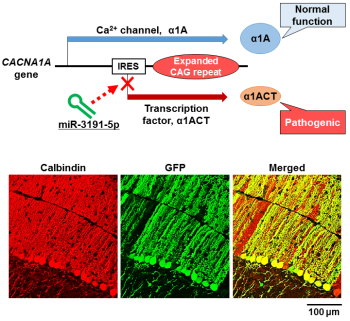A microRNA-mediated gene therapy for spinocerebellar ataxia -Selective blockade of toxic protein translation-
A microRNA-mediated gene therapy for spinocerebellar ataxia -Selective blockade of toxic protein translation-
Spinocerebellar ataxia (SCA) is characterized by slowly progressive ataxia and loss of cerebellar neurons. To date about 40 causative genes are identified. However, no disease modifying therapy is available. SCA6, the second common type of dominantly inherited SCAs in Japan, is caused by an expanded CAG trinucleotide repeat in CACNA1A gene. In 2013, researchers at University of Chicago reported that a second CACNA1A gene product, α1ACT rather than calcium channel, a gene product of the full-length CACNA1A gene, is the actual culprit of the disease.
Prof. Shin-ichi Muramatsu at the Center for Gene & Cell Therapy, the Institute of Medical Science, the University of Tokyo, in collaboration with Dr. Yu Miyazaki and Dr. Christopher M. Gomez at the Department of Neurology, the University of Chicago, developed a novel microRNA-mediated therapeutic approach for SCA6. They identified miR-3191-5p as an microRNA (miRNA) that preferentially inhibited the translation of α1ACT. To test the therapeutic effects of miR-3191-5p, they first developed an SCA6 mouse model using an adeno-associated virus (AAV)–based gene delivery system to express expanded repeat form of α1ACT (α1ACTSCA6). The newly designed AAV vector can transduce Purkinje cells in the broad region of the cerebellum efficiently. Mice expressing α1ACTSCA6 exhibited early-onset ataxia, motor deficits, and Purkinje cell degeneration in the cerebellum. Furthermore, AAV-mediated-delivery of miR-3191-5p protected mice from the ataxia, motor deficits, and Purkinje cell degeneration. Thus, miRNA-mediated α1ACTSCA6 silencing would have great potential benefit for SCA6 patients.
